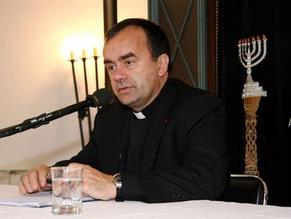|
World Jewish News

''We cannot build Europe and democracy upon the mass graves of forgotten victims,'' Patrick Desbois told participants in a seminar on WWII mass graves.
|
Protecting WWII mass graves is a duty to victims
03.07.2011, Holocaust Hundreds of Holocaust-era mass graves are scattered around Eastern Europe, scholars said Friday, urging authorities to protect them as they owed it to victims of World War II atrocities.
"We cannot build Europe and democracy upon the mass graves of forgotten victims," Patrick Desbois, a French Catholic priest who set up the Yahad-In Unum association, told participants in a seminar on WWII mass graves.
The Paris-based association has embarked upon the gruesome task of documenting extermination sites in Ukraine, Belarus, Russia and Poland.
"We have received hundreds of letters from people asking: 'in which mass grave is my grand-mother or my uncle buried'," Desbois said.
"We have a duty to victims because each and every one of them had a name."
A historian with the association, Patrice Bensimon, said that 650 mass-grave sites had been identified on the outskirts of villages, in valleysor forests in the four countries since 2004.
After interviewing more than 1,850 eyewitnesses, Desbois said he had come to a shocking conclusion: "I thought they were done secretly, but the shootings were public. People watched, thinking the executions were interesting."
In one case, a witness aged seven at the time of the pogrom recounted how he had watched Jewish children aged 0 to 6, some 800 of them according to archives, being massacred in the Transdniestrian village of Bogdanivka (now part of Ukraine).
"How can you be a seven-year-old and watch all day the assassinations? This is a big human question," Desbois wondered.
"Most Holocaust victims lying in mass graves and still waiting to be remembered are in this part of Europe," Paul Shapiro, director of the centre for advanced studies at the Holocaust Museum in Washington, said.
He stressed that more than one million people, and maybe up to one third of the six million Jews murdered during WWII, were slaughtered in Eastern Europe, in their own villages, in front of neighbours and family members.
Roma, Soviet POWs, higher echelons of Polish society and homosexuals also lie in unmarked mass graves, he said.
"The multitude of mass graves and the implication of forces acting under different authorities make the situation in Eastern Europe more complicated," Radu Ioanid, director of the Holocaust Museum, told AFP.
After having for years denied any role in the Holocaust, Bucharest accepted the conclusions of an international commission of historians saying that up to 380,000 Romanian and Ukrainian Jews were murdered or died in Romania and the territory under its control between 1940 and 1944, during the regime of pro-Nazi marshal Ion Antonescu.
In one of the worst single WWII massacres, the June 1941 pogrom in the northern Romanian city of Iasi, nearly 15,000 Jews were shot dead in the street or asphyxiated in "death trains".
"The killings elicited no negative reaction from the population," Shapiro said.
A mass grave containing the bodies of at least 35 Jewish men, women and children killed by the Romanian army in 1941 was discovered in a forest at Popricani, near Iasi, last November. The remains were exhumed before being properly reburied five months later.
But Popricani was an exception.
"We do not open mass graves, because Jewish law does not allow it," Desbois said.
What his team does is transmit the GPS data to the American Jewish Committee so that the exact location may be entered into archives that will eventually be posted on the internet. The Committee is expected to launch soon, jointly with Germany, a project to protect some of the mass graves.
Apart from the local authorities' indifference, scholars like Desbois must also fight the threat of construction or industrial projects destroying the graves.
"But the biggest problem is that time is running out, as witnesses are dying," Bensimon said.
EJP
|
|
